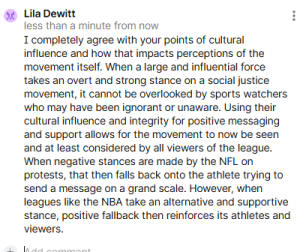3
Section One: The Fundamentals
A) Keywords
Exercise 1:
Briefly (in 100 words or less) define one of the keywords in the padlet (including one that you. may have added yourself).
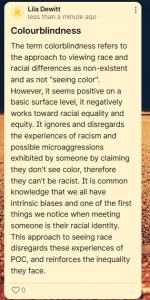 |
B) Representing Race
Exercise 2: Notebook Prompt
In about 50-70 words, consider Joel Bervell’s question: why do we feel the need to extrapolate the athleticism of one Black athlete to all Black people when we do not do the same for white athletes?
Try to think of examples when this happens, making sure to reflect on your own positionality.
| I believe the reason behind extrapolating athleticism of one black athlete to all black people when we don’t do so for white athletes resides in the idea of white biological and social supremacy. When a white person is exceptional, it is seen as normal and natural. However, when a black person beats a white person for instance, it is seen as unnatural and therefore he must be a part of a biologically more developed racial or ethnic group.
|
C) Gender, Race & Sport
Exercise 3: Notebook Prompt
What are some strategies for resistance that Rajack and Joseph identify in their article as a means of pushing back against and resisting misogynoir?
| Self-representation and comedy were discussed as methods of resistance used particularly by Naomi Osaka towards racist journalists and “comedians” in Japan. Within the comedic realm of resistance, it provides opportunities to fight against misogynoir by making fun of the racists themself. By taking the power of their words away by making fun of their poor, uncreative, and pointless comedy, the perceived power dynamic is turned against them. Osaka can turn the poor comedy and questions back onto the people discriminating against her, and make fun of them in return. This ultimately discredits their attempts at getting people to laugh at her and instead causes people to laugh at their ideocracy instead. Self-representation is also another example of resistance against misogynoir. Osaka self represents both aspects of her identity and proudly adopts the blasian identity on her social media, and publicly within the tennis scene. By being loud and proud of her identity, people do not have the opportunity to disregard certain aspects of her identity that do not fit into the cultural norm. Her self-representation through her displays of both aspects of her Haitian and Japanese identity causes for people to be unable to ignore her Haitian identity. If attempts are made to ignore this part of her identity, she reinforces the idea that this ignores half of her being, and ensures to make that clear. Limiting restrictive media representations through advocating for both components of her racial identity allows for her to express aspects of her ethnicity that aren’t welcomed in the social norms of different countries.
|
Section Two: Making Connections
A) Athlete Activism
Exercise 3: Padlet Prompt
Do athletes have a responsibility to use their platform for social change? Why or why not? Please remember to record your response in both the padlet below and in your Notebook.
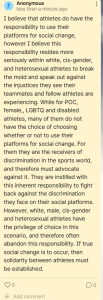
B) Athlete Activism & Feminism
Exercise 4: Complete the activities
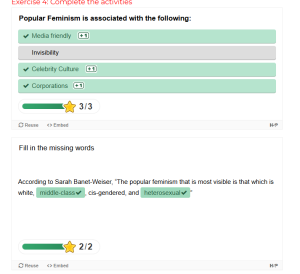

Exercise 5: Notebook Prompt
What do the authors of the article call for as a way of challenging how mainstream sports journalism privileges neoliberal feminist concerns? (100 words max.)
| The authors call for telling the story differently as a method of challenging how mainstream sports journalism privileges neoliberal feminist concerns. To do so, you must investigate and question the stems of sports media, and where/who these narratives stem from. Sports is widely male-dominated and mainly focuses on the male point of view in media and journalism. By illuminating the different ways of knowing and being through women of color voices, a new perspective on sports journalism can be understood and highlighted. By informing sports media through feminism, the stories can be told differently, and more inclusively.
|
C) Corporate social justice
Exercise 6: Padlet Poll
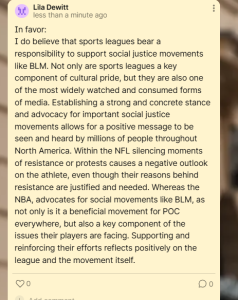
|
Section Three: Taking a shot
Module Assignment (submit as part of notebook and separately through Blackboard mini assignment #1 portal)
A movie that comes to mind when speaking about racialized athlete activism is “Remember the Titans”. The popular movie is about an integrated high school that allows black students, black football players, and black coaches alongside their white counterparts. Throughout the movie, internal school racism and discrimination along with external social discrimination and violence are forces at play working against the black students attending the school and playing football. This illuminates to the school athletes that sports and schools do not operate culturally outside of the broader culture and instead perpetuate the broader racial inequalities on a grand scale (Gailily, 2019). One act of athlete activism within the film was sharing components about each other and their culture, and how aspects of their identities are important, but race is not the only thing important about their identity. This act of sharing components of their cultural identity helps develop a more personal relationship with their new teammates and construct an idea of each other outside of race allowing them to think outside the concepts of broader society at the time. Moreover, when a space is provided for them to discuss the issues they face and their experiences, the two groups can come together and work against it together (Gailily, 2019). This unified force against the broader concepts of race and racism operates as a mode of activism against the inequalities the black athletes face, where solidarity starts as the primary force of resistance. Commentary on these efforts throughout the movie is met with negative reactions from broader society as it works against the unified norm. Coach Boone faced racial threats from the community in response to his efforts of integrating the football team to be more inclusive. This representation of white and black relations in the southern states of the US at the time is reflected in the film, as racism and segregation were the cultural and societal norm for centuries before integration. These representations in film shape how we understand the sport itself as football culturally is a sport enjoyed by all races. Football has been a culturally important sport for white and black people for decades, and many people, view this game as a place of solidarity and sportsmanship. Within the movie, the development of sportsmanship is deliberate between the two sides, and eventually grow to share and develop relationships with each other. Overall, football in this movie is depicted as a sport of teamwork, and activism within the film consists of sharing cultures and open discussion about their identities.

